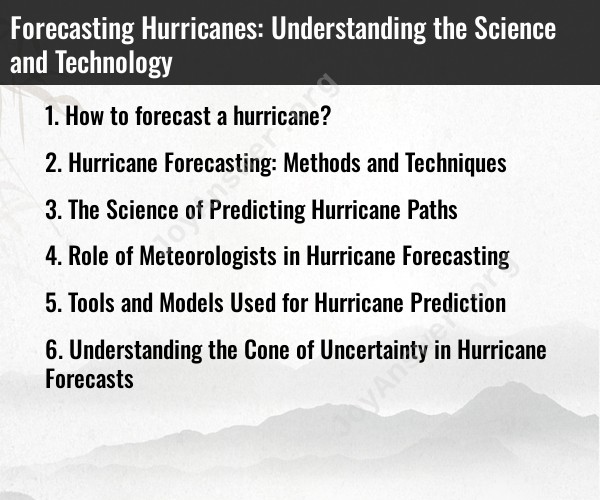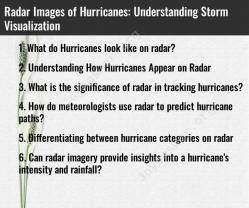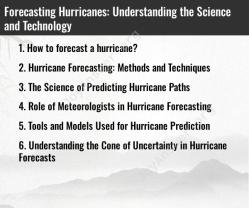How to forecast a hurricane?
Forecasting hurricanes is a complex and crucial task that involves a combination of science, technology, and meteorological expertise. Meteorologists use various tools and data sources to predict the track, intensity, and potential impacts of hurricanes. Here's an overview of how hurricane forecasting is done:
Data Collection:Meteorologists gather extensive data from various sources, including:
- Satellite imagery: Satellites provide a view of the storm's size, structure, and movement.
- Weather stations: Data from ground-based weather stations provide information on temperature, pressure, and wind conditions.
- Ocean buoys: Buoys in the ocean collect data on sea surface temperature and wave heights.
- Aircraft reconnaissance: Hurricane hunters fly into the storm to collect real-time data on pressure, temperature, humidity, and wind speed and direction.
Modeling:Meteorologists use computer models to simulate the behavior of the hurricane. These models take into account the data collected and use complex mathematical equations to predict the hurricane's future path and intensity. Some well-known models include the GFS (Global Forecast System) and the European Center for Medium-Range Weather Forecasts (ECMWF) model.
Track Forecasting:The primary focus of hurricane forecasting is to predict the storm's track. Meteorologists use a variety of models and historical data to create a "cone of uncertainty" that represents the potential path the hurricane might follow. This cone indicates where the hurricane is likely to be within a given timeframe.
Intensity Forecasting:Predicting the intensity of a hurricane is challenging. Changes in sea surface temperature, wind shear, and other factors can affect the storm's strength. Forecasters use model guidance and real-time data to estimate how the hurricane's intensity may evolve over time.
Timing and Impact Forecasting:Forecasters also provide information on when the hurricane is expected to make landfall and the potential impacts, including storm surge, heavy rainfall, and strong winds. This information is crucial for emergency preparedness and response.
Public Alerts and Warnings:Once a hurricane's path and impact are better understood, meteorologists issue alerts and warnings to the public. These warnings provide information on evacuation orders, storm surge, wind speeds, and rainfall predictions.
Constant Monitoring and Updates:Hurricane forecasting is an ongoing process. Meteorologists continually monitor the storm's progress and update forecasts as new data becomes available. Timely updates are crucial to keeping the public informed.
It's important to note that hurricane forecasting has improved significantly over the years, thanks to advances in technology and increased understanding of the science behind hurricanes. However, there are still uncertainties, especially in intensity forecasting, and hurricanes can be unpredictable. This is why it's essential for individuals and communities to stay informed and follow the guidance of authorities during hurricane events to ensure safety and preparedness.
Hurricane Forecasting: Methods and Techniques
Hurricane forecasting is the process of predicting the formation, intensity, and track of hurricanes. Hurricane forecasters use a variety of methods and techniques to make their predictions, including:
- Satellite imagery: Satellites provide forecasters with a real-time view of the atmosphere and oceans. Forecasters can use satellite imagery to track the movement of storms, identify areas of convection, and measure storm intensity.
- Radar data: Radar data can be used to track the movement of storms and measure their precipitation rates.
- Ground observations: Ground observations, such as wind speed and direction, temperature, and pressure, can be used to validate satellite and radar data and to improve hurricane forecasts.
- Numerical weather prediction (NWP) models: NWP models are computer models that simulate the atmosphere. Forecasters use NWP models to predict the future movement and intensity of storms.
The Science of Predicting Hurricane Paths
The science of predicting hurricane paths is complex and involves a number of factors, including:
- The steering currents: The steering currents are the winds that guide the movement of hurricanes. Forecasters use NWP models to predict the future movement of the steering currents.
- The Coriolis effect: The Coriolis effect is caused by the Earth's rotation. It causes hurricanes to curve to the right in the Northern Hemisphere and to the left in the Southern Hemisphere.
- Land interaction: When hurricanes make landfall, they can interact with the land in a number of ways. This can cause them to slow down, change direction, or weaken.
Role of Meteorologists in Hurricane Forecasting
Meteorologists play a vital role in hurricane forecasting. They are responsible for collecting and analyzing data, developing and running NWP models, and issuing hurricane forecasts and warnings.
Meteorologists work at a variety of organizations, including the National Hurricane Center (NHC), the National Weather Service (NWS), and private weather forecasting companies.
Tools and Models Used for Hurricane Prediction
A variety of tools and models are used for hurricane prediction, including:
- Satellites: Satellites provide forecasters with a real-time view of the atmosphere and oceans.
- Radar: Radar data can be used to track the movement of storms and measure their precipitation rates.
- Aircraft: Aircraft can be used to collect data on the atmosphere and oceans, including wind speed and direction, temperature, and pressure.
- Numerical weather prediction (NWP) models: NWP models are computer models that simulate the atmosphere. Forecasters use NWP models to predict the future movement and intensity of storms.
Some of the most commonly used NWP models for hurricane prediction include:
- The Global Forecast System (GFS): The GFS is a global NWP model that is run by the National Oceanic and Atmospheric Administration (NOAA).
- The Hurricane Weather Research and Forecasting (HWRF) model: The HWRF model is a regional NWP model that is specifically designed for hurricane forecasting.
- The European Centre for Medium-Range Weather Forecasts (ECMWF) model: The ECMWF model is a global NWP model that is run by the European Centre for Medium-Range Weather Forecasts.
Understanding the Cone of Uncertainty in Hurricane Forecasts
The cone of uncertainty is a graphical representation of the possible tracks of a hurricane. The cone is widest at the beginning of the forecast and narrows as the forecast gets closer to the storm's arrival.
The cone of uncertainty is important to understand because it shows that hurricane forecasts are not always accurate. The actual track of a hurricane can fall outside of the cone of uncertainty.
There are a number of factors that can cause hurricane forecasts to be inaccurate, including:
- Errors in the data used to initialize the NWP models.
- Errors in the NWP models themselves.
- The chaotic nature of the atmosphere.
Despite these challenges, hurricane forecasts have become increasingly accurate in recent years. This is due to a number of factors, including:
- Improved data collection and analysis techniques.
- Improved NWP models.
- A better understanding of the factors that influence hurricane formation and movement.
Hurricane forecasts are an essential tool for hurricane preparedness and response. By understanding the science of hurricane forecasting and the cone of uncertainty, individuals and communities can make informed decisions about how to protect themselves from hurricanes.



